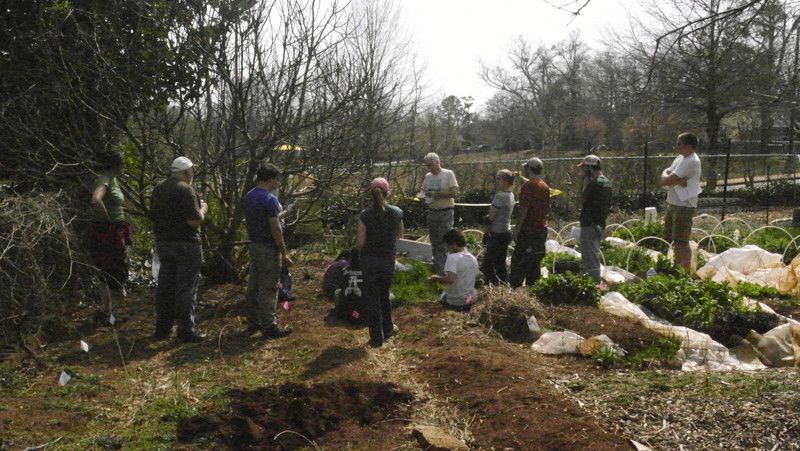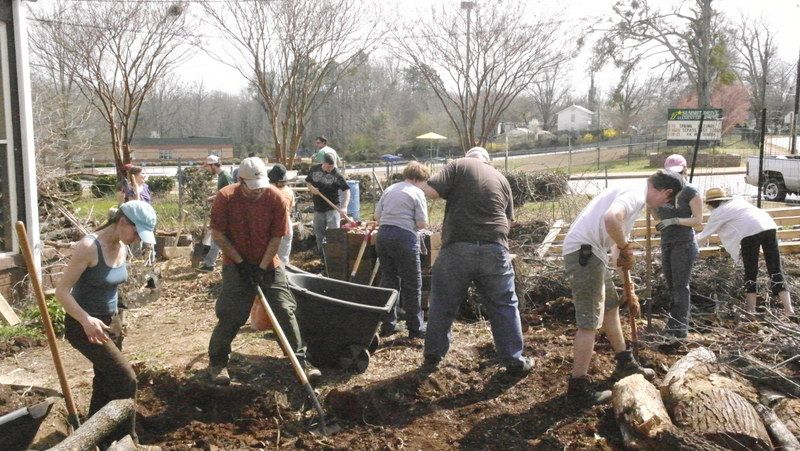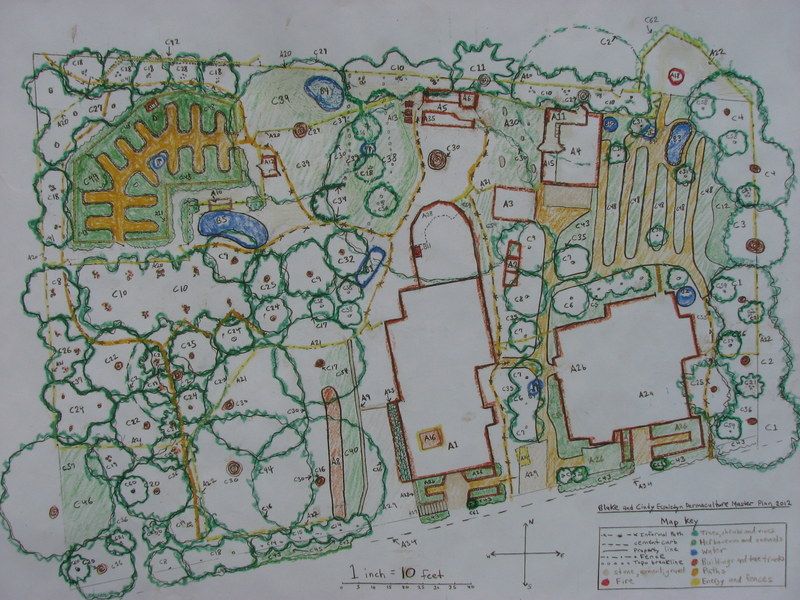That said, we're planning to host 1 "official" SCUPS permablitz approximately once a month. As our group grows and more people resources are available, that might expand.
SCUPS "official" permablitzes (let's call them "SCUPSablitzes" from here on out) will be held during the middle-of-the-month on Saturdays to space them apart from our meetings (which are 1st Sundays). The only prerequisite to hosting a SCUPSablitz is that you've attended at least 3 other member's blitzes (any member's permablitzes count, they don't have to be SCUPSablitzes).
Currently open SCUPSablitz dates are:
- April 19th (recommend only 1 or 2 projects unless you already have a lot of materials and plans set up)
- May 17th
- June 21st
- July 19th
- August 16th
- September 20th
- October 18th
- November 15th
- December 13th
Having a SCUPSablitz isn't too different than doing one on your own. The main benefit is we'll create a Facebook group event invite for all our members and we'll announce it on our newsletter. We'll also post reminders to encourage people to attend. If you need it, we'll get someone with a PDC to look over your design to make sure it works (if you weren't able to have one made by a PDC designer).
Beyond that, it's very likely you can find most of your leadership role volunteers among the SCUPS membership. However, it will be up to you to ask each one individually what they are willing to contribute towards your SCUPSablitz. You should also consider your own friends and family as possible leaders or invite them as volunteers.
Whether you do a SCUPSablitz or just plan your own permablitz, here's what we recommend based on research and experience:
- Get the design completed and checked as early as possible so you can iron out kinks. This is especially important if you are relying on someone with a PDC to volunteer to look at your design -- we do not have a ton of members with PDCs yet and the few we have may be busy and difficult to schedule time with. Some PDC designers may request payment for their expertise -- please understand this may be their livelihood and recognize the value of their skills (if you can't find a designer to look at your site plan for free, use this contact form to let Eliza know -- we'll try very hard to look over your design for free if it is for a SCUPSablitz. We can't make promises that free services will be done in a timely manner). You need to design your entire site before we'll consider spending our members' time and energy there for a SCUPSablitz -- permaculture designs need to include whole system foresight and planning -- it isn't a good idea to just stick an herb spiral or hugel bed in a random spot.
- SCUPSablitz dates are going to be first come, first serve to qualified members and we'll try not to do repeats at the same site if there are members who haven't had a turn yet. Again, to be qualified you need to have attended 3 or so member's permablitzes and you need to have a PDC designer approved site design.
- Take a look at the organizer guides on permablitz.net to help you plan your blitz (also keep in mind our group is currently much smaller than Melbourne's).
- Email any questions you have to Eliza or post them on the SCUPS Facebook group -- we are happy to help you as much as you need in this manner. Don't feel badly if you have a ton of questions (or if you're frequently posting them to the group because when you post it in public, many people can learn from your queries). We have lots of newbie members plus even the experts are always learning.
- Try to find an expert mentor or two to help you with your planning... but if you can't, just see #4 and post lots of questions.
- Choose which projects from your design you most want to do at your blitz. It's unlikely we can complete more than 4 projects in a day unless you have another large group to invite (like your garden club, school, church, etc.). You also need to keep in mind how much room you have for people to work on your property -- a small yard will necessitate fewer projects than somewhere with acreage. Also note some projects (like cob building or ponds) may take more than one day. Detailed projects that require micromanagement are not good options for a permablitz. Decide beforehand if you're comfortable with a project not turning out exactly how you'd imagined (and remember the labor is free).
- Order the projects you choose from the highest priority to least. Choose a couple additional smaller projects or crafts that people can do on the sidelines if there are more volunteers than jobs (examples: separating saved seed from chaff, shucking beans, sorting materials, moving materials, weeding, removing tape/staples from cardboard, making seed bombs, building mason bee houses, etc.).
- Plan at least one short, 20 or 30 minute educational workshop as a treat for your volunteers. This usually is a small talk, tour, walkthrough, or hands-on demo. It isn't a good idea for the host, facilitators, or team leaders to be the workshop leader unless alternative people are filling their job while they are teaching the workshop.
- "Hire" people to lead your blitz. It's good to network in SCUPS so you have plenty of people to ask about their availability. Don't forget your non-SCUPS friends and family as possible options, too. Here are the "jobs" you need to fill for a typical 2 - 4 big project permablitz:
- The main host/site owner -- In charge of hiring everyone else, obtaining a permaculture site design, negotiating a SCUPSablitz date (if applicable), choosing projects, obtaining all project materials, obtaining and serving food, making signs (you can delegate any of these things if you find willing helpers)
- The designer -- This person creates a permaculture plan for the site. This can be the host/site owner, main blitz facilitator, etc. or it can be someone else entirely.
- Main blitz facilitator -- Has the overview of everything that is going to go on during the day and needs to constantly check in with each project to make sure it is running smoothly. Keeps an eye out for people who need to feel useful. This person should NOT do much, if any, labor on individual projects in order to stay focused on the big picture. If this person is also the site owner, then a separate "host" should be hired to manage food and other "home" site tasks.
- Assistant blitz facilitator -- Main job is keeping an eye out for people who need to feel useful, greeting people as they arrive and familiarizing them with projects, checking people are drinking water, and doing anything the main facilitator asks.
- Gopher (can have 2 of these for big blitzes) -- People are going to constantly need stuff all day. A gopher should carry a pen and paper (like a waitress) to help their short term memory stay on track. It's important that the main blitz facilitator not be the gopher. It's helpful if at least one of the gophers is a good friend or family member that knows where things are in the house and on the site.
- Team Leaders -- Each major project should have a designated team leader to facilitate it. Smaller projects can just have signs with step-by-step instructions for people to do on their own time. Make sure your team leaders are trained prior to the blitz to know what the project priority is, where their project goes in your landscape, step-by-step what they are supposed to do, which materials belong to their project (and if they are sharing those materials with anyone), and any other relevant info. This is ideally discussed with a team leader in person on site prior to the blitz. It is a great idea to have an illustrated sign at each project demonstrating what the end goal is. Some volunteers arrive later in the day (or migrate from other projects) and the team leader rarely has the ability to explain it in full to each newcomer. Ask team leaders to send volunteers who aren't feeling useful to the blitz facilitators for job suggestions.
- Workshop leader/s to teach 20 or 30 minute educational workshops to your volunteers. You only need one or two held at a set time during the blitz (announce in the invite or at least in the welcome circle in the morning when the workshop will be). This can be on any permaculture/homesteading topic you can think of. Examples are backyard chicken care, beekeeping, building a hot compost pile, hugelkultur, winter gardening, canning, fermenting, seed saving, grafting woody plants, pruning, edible weeds identification, paper-making, soap-making, woodworking, cooking demos, etc. Remember that your volunteers are getting education out of the event while you are getting mass labor.
- You can "hire" anyone else you like -- cooks, babysitters, sign makers, etc. It all depends on who you know that is available to help. It's also up to you how many of the above jobs are shared by the same person. We strongly caution against the hosting job or main facilitator job being combined with other jobs.
- Consider logistics -- where are the bottlenecks on your property? Can the hugelkultur bed not be completed until the pond soil has been excavated to put on top of it? Are you able to build the paths in the swales or do you need to wait for irrigation lines to be laid? Do you have enough wheelbarrows? Trucks? Did you offer gas money to truck drivers who volunteer to deliver materials for you? Are all the materials already delivered? Are the projects you chose spaced far enough apart that everyone has room to work? Are the projects you chose safe for your volunteers? Do you have a backup plan? Are you prepared for projects that don't get finished and materials that are still in the way after the blitz? Do you have the next day free, because you're going to be tired and your property is going to need a cleanup? Have you planned for bad weather? Is your site small enough that your blitz needs to be RSVP only and have an attendees cap?
- Once you've solidified a date for a SCUPSablitz, you need to submit a summary of your event, an address, the date, time, and other relevant info to Eliza for the SCUPS group invite & newsletter.
- Permablitz.net says that "It's rare that more than 20 people can be 100% utilised for a whole day on a suburban site, but nevertheless blitzes of 50 or more can be great successes if there are simultaneous projects, and enough facilitators and workshops"
Typical Blitz Schedule:
- An hour before the blitz: The host, facilitators, and team leaders meet to finalize the plans for the day before everyone arrives. If people arrive early, they can be given simple tasks like pulling tape/staples off cardboard or organizing materials.
- 10:00am welcome people, let them sign in (there should be an email signup area for SCUPS plus "credit" for attending a blitz), possibly offer name tags (this was requested after the March SCUPSablitz), assign simple tasks, direct people to refreshments if they're available
- 11:00am Everyone stops for a meet & greet circle plus the host or facilitator explains the overall permaculture design for the site and the plans & projects for the day's blitz. Announcements like workshop times and team leader introductions are made. It's a good idea to talk about tool safety, labeling tools, and back care. It's also a good idea to offer a first aid station and sunscreen. Alert people to where they can fill water bottles (and put up signs, since some people arrive late and don't hear the announcements).
- 11:30am Volunteers distribute themselves on teams and the real work begins. If there are more volunteers than projects, harness the energy in side projects & workshops. (Some people might be able to set up impromptu side projects if you ask them).
- 1:00pm Lunch (please offer a vegetarian option, though people with very specific dietary needs should bring their own lunches). Remember everyone is working and is likely to want something filling with good protein. Suggestions:
- Soup (vegetarian & omnivore, with bread or chips)
- Chili (vegetarian & omnivore, with tortilla chips)
- Sandwich bar (breads, peanut butter, honey, jam, deli meats, cheeses, veggies, condiments, etc.)
- Locally sourced a plus
- 1:45pm Back to work!
- 5:00pm Work stops even if it isn't finished and there is a walkthrough of all the projects. Team leaders talk about any hiccups along the way and how they were circumvented. The purpose of the project and its end goal is made clear to the volunteers (keep it educational).
- Sometimes everyone is tired and just wants to go home to a shower, but blitz hosts are encouraged to announce an optional potluck dinner so everyone can socialize and enjoy looking at the fruits of their labor. Another option is having a grill or cob oven running so people can bring foods to cook in them.
 |
| Photo Caption: The beekeeping workshop at the March 2014 SCUPSablitz. |



Things I'm willing to do on a volunteer basis when I happen to be available (please ask well in advance):
ReplyDelete* Team Leader
* Answering unlimited online questions about blitzes and design
* Leading short workshops at your blitz
I'm less likely to be available right now for the more time consuming jobs unless you're willing to pay me for my time.
Happy blitzing! :)
- Eliza Anne
OH! I should add that we bought a 42 cup coffee maker, large capacity hot pot, and a ton of ceramic mugs from the thrift store that I am happy to bring to events if I'm available.
DeleteI'd also be open to volunteering as the assistant facilitator doing the greetings & finding ways to make people feel useful.
Here is a check list for folks to use in planning their blitzes if they would like to: https://drive.google.com/file/d/0B6MTyqdm-770amx5Z1hGLVZDZ28/view?usp=sharing
ReplyDelete